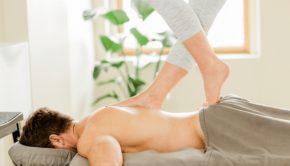Bodywork Goes Mainstream
Helpful Access Points to Health
Once considered a luxury for the pampered few, massage was among the first therapies to be widely recognized by physicians as a respected aspect of integrative and functional medicine. Bodywork increasingly shares this status, as it is included in conventional medicine’s more innovative healthcare models that embrace a body, mind and spirit approach. One of many examples is Duke Integrative Medicine, in Durham, North Carolina, where patient services include a form of integrative massage that blends Swedish massage, myofascial therapy, reflexology, energy work and somatic therapy techniques.
In the public’s view, bodywork is still largely associated with massage, although distinct forms stand on their own, including Rolfing, structural integration, shiatsu and myofascial and craniosacral therapies. Bodywork professionals generally belong to the American Massage Therapy Association (AMTA), whatever their specialized modality. They may also participate in other professional organizations, such as the Associated Bodywork & Massage Professionals, which has some 80,000 members, many of which are also members of the International Association for Structural Integrators. These nonprofits’ websites help individuals locate practitioners in their area.
According to Maureen Moon, past president of AMTA, many massage therapists (which don’t refer to themselves as bodyworkers) are trained in various bodywork therapies and intuitively integrate them into their sessions, depending upon each client’s needs.
The seed holds within itself hints of its magnificent maturity. So it is with the practice of whole-person health care, which has matured in language, sophistication, credibility and acceptance. In a single generation, we’ve seen its presence grow from the outer edges of holistic and alternative wellness to complementary and integrative health care. Its latest evolution into America’s mainstream is known as functional medicine. The branch of massage therapy, the germination point for myriad therapies collectively known as bodywork, patterns the movement’s development.
She notes that, “Many AMTA members are so passionate about their profession and meeting the continuing education (CEU) requirements that they go far beyond the units required to maintain their license, which can vary from state-to-state.” For example, Moon has trained in spinal reflex analysis, developed by Dr. Frank Jarrell, neuromuscular and craniosacral therapies, shiatsu and seven massage therapies. “Most AMTA members are CEU junkies,” quips Moon, who points out that national conventions provide continuing education and chapter meetings frequently introduce attendees to new techniques. Some practitioners discover specialties while in search of pain relief for personal injuries or other conditions.
Myofascial Therapy
Olympia Hostler, a myofascial therapist in Tinton Falls, New Jersey, had two serious horse riding accidents during adolescence and three automobile accidents by age 40, which combined, left her so incapacitated that she could barely walk. “I couldn’t work for three years, because I was so debilitated,” relates Hostler. She found her doctor’s diagnosis of severe permanent damage to the body’s soft connective tissue, or fascia, and the prognosis of a lifetime of living with pain unacceptable. So she began searching for something that would help restore health. Her investigation of therapies ended with myofascial release, an effective whole-body approach to the treatment of pain and dysfunction, developed by Physical Therapist John F. Barnes.
“I had several sessions and found lasting pain relief unlike anything I’d ever experienced,” advises Hostler. Unlike massage therapies focused on improving circulation, inducing relaxation or draining lymph fluid, the myofascial treatment reached Hostler’s deepest layer of fascia to free the restrictions causing her pain. “It was amazing that a hands-on application of gentle, sustained pressure into areas of restriction in the myofascial connective tissue could begin to relieve many years of ongoing, intense pain,” says Hostler.
Rolfing
As a Certified (advanced) Rolfer and Rolf Movement Practitioner, Robert McWilliams has been able to pursue his lifelong passion in the fields of movement and physical fitness, which included 25 years as a professional dancer and 14 as a professor of modern dance. He taught at both the University of Oklahoma and the University of Florida, in Gainesville.
“In the 1980s, while I was still dancing, I had an experience with Rolfing, developed by Ida P. Rolf [Ph.D.], that transformed my dancing, increased my athletic performance alignment, coordination, flexibility, balance, muscle tone, expressive power and overall sense of relaxation onstage, as well as in daily life,” relates McWilliams. He currently serves as an assistant teacher at the Rolf Institute of Structural Integration, in Boulder, Colorado, where he trained.
Although McWilliams’ clients generally see him to treat the pain and discomfort of injuries, he says that they frequently change their focus to how their body is working better overall. “This is because injuries tend to resolve themselves after a few sessions of deep tissue manipulation of the myofascial system,” says McWilliams.
A specialized series of 10 sessions works to systematically balance and optimize both the structure (shape) and function (movement) of the entire body. Each session focuses on freeing up a particular region of the body. The effect releases old limiting patterns and postures and restores the body’s natural alignment and sense of integration. “Often, as freedom of physical expression increases, so does emotional expression,” comments McWilliams.
Structural Integration
“While Rolfers graduate from The Rolf Institute and attend certified training programs in order to maintain their trademark, and structural integrators can attend any of 14 certified U.S. schools, we are all structural integrators; our training is based on the work of Ida Rolf,” says Diane Roth, a board-certified structural integrator who has specialized in massage and bodywork for 25 years in the Chicago area.
Roth explains that all practitioners in this field of study combine hands-on freeing and realigning of fascial tissue with awareness and movement education, in order to structurally integrate the whole body. Restoration of postural balance and functional ease greatly helps the body, which, she says, constantly labors against the powerful force of gravity.
Like Moon, Roth has studied and incorporated other adjunct therapies and modalities, such as craniosacral therapy and myofascial release. From her perspective, bodywork differs from massage in that it requires more involvement from the client.
“I tell my clients that with a veritable village of treatments available, there is always help for anyone that suffers with aches and pains, regardless of age,” says Roth.
Shiatsu
Shirley Scranta, owner and director of the International School of Shiatsu, in Doylestown, Pennsylvania, discovered The Book of Shiatsu: The Healing Art of Finger Pressure, by Saul Goodman, in a health food store. She subsequently researched the school that Goodman founded in 1978, based on the theories of masunaga Zen shiatsu, kushi macrobiotic and his own shiatsu shin tai.
In 1996, Scranta became one of Goodman’s clients. “I drove a round-trip of 240 miles for weekly treatments because each session made me feel better and stronger. After five sessions, I enrolled in classes and graduated later that year,” says Scranta. She believes the widely known form of acupressure helped her body reestablish its own intelligence system, which had been distorted by childhood trauma.
“This gentle technique applies varying degrees of pressure to release tension, strengthen weak areas, facilitate circulation and balance the life energy that flows through the meridians in the body,” she explains. “In my case, it helped me connect with my body so that I could honor it and do what it needed to rejuvenate itself.”
Craniosacral Therapy
Chiropractor Lisa Upledger is vice president of The Upledger Institute, in Palm Beach Gardens, Florida. A craniosacral therapy (CST) practitioner, educator and wife of CST developer Dr. John Upledger, she advises that tension-related problems are a growing complaint in our modern world. Fortunately, such issues are among the myriad conditions that respond quickly to the gentle touch of this modality.
In a 2007 Massage magazine article, she advised that the positive effects of the therapy rely to a large extent on the performance of the body’s inherent self-corrective mechanisms. “CST works through the craniosacral system to facilitate this function and thereby normalize the environment in which the central nervous system functions,” she noted. “As this is accomplished, a wide range of sensory, motor and neurological problems are improved.”
CST practitioners listen with their hands to the slow pulsations of the craniosacral system. With a soft touch, equivalent to the weight of a nickel, they explore any fascia restrictions throughout the client’s body, which rests fully clothed in a supine position. Effects of the treatment can be wide-ranging, affecting the musculoskeletal, nervous, cardiovascular and immune systems as well as organs, connective tissues and energy systems. It works to release deeply held physical and psychological patterns held within the body.
A coin with different impressions on each side is still only one coin, a blend of precious metals. When the coin is tossed to reveal either heads or tails, the visible symbol is one interpretation of the whole imprint—an analogy that may best define the difference between massage and bodywork. All variations on the theme share the same goal—restoring health to the whole person.
Linda Sechrist is a senior staff writer for Natural Awakenings. Find other natural living articles at her website, ItsAllAboutWe.com.
For More Information
International Association of Structural Integrators,
Theiasi.org
International School of Shiatsu,
Shiatsubo.com
Myofascial Release Treatment Centers & Seminars,
MyofascialRelease.com
Rolf Institute of Structural Integration,
Rolf.org
Upledger Institute International (craniosacral therapy),
Upledger.com




























